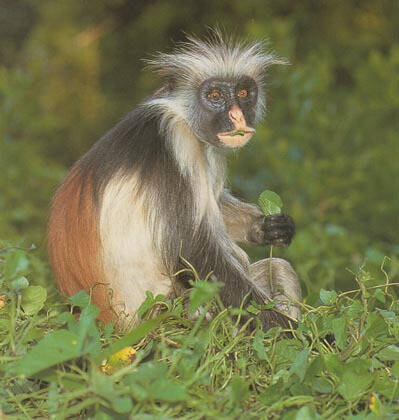Piliocolobus preussi
IUCN
LCBasic Information
Scientific classification
- name:Piliocolobus preussi
- Scientific Name:Piliocolobus preussi,Preuss’s Red Colobus,Preuss's red colobus
- Outline:Primates
- Family:Cercopithecidae R.Colobus
Vital signs
- length:45-67cm
- Weight:About 4.5kg
- lifetime:No verification information
Feature
The whole body is covered with long hair, without tufts, and the fur is brightly colored
Distribution and Habitat
Distributed in Cameroon and Nigeria, it inhabits coastal forests and native vegetation areas in waterways.
Appearance
The body of the Przewalski's red colobus is slender, with a head-body length of 45-67 cm, a tail length of 52-80 cm, and a weight of about 4.5 kg. Like other colobus species, the anal warts are small, the tail is long, and the cheek pouches are smaller than those of ordinary monkeys. They are different from leaf monkeys in that they have no thumbs, although the other fingers are particularly long, and the thumbs have degenerated into a small wart, hence the name colobus. The Przewalski's red colobus is different from other species of the same genus. The whole body is covered with long hair and there are no tufts of hair. The bright colors are very attractive. The head, upper body, arms and legs are mainly black, gray, brown, red or chestnut. The fur around the pubic area is white. The genitals of subadults of both sexes are swollen like those of females, probably to prevent the males from being expelled from the group by mature males when they are immature.
The Przewalski&
Details
Preuss’s Red Colobus (scientific name: Piliocolobus preussi) is also known as Preuss’s Red Colobus. It was once a subspecies of the West African red colobus.

Preuss’s Red Colobus is a diurnal animal. It is arboreal and moves quickly between species. The complex structure of their stomachs has been adapted to digest leaves. They are completely vegetarian, eating large amounts of leaves every day, and occasionally eating fruits, mosses and seeds, with a daily intake of up to 2-3 kg. They also eat soil and charcoal to help digest toxins on the leaves.
The distribution range of the Przewalski's red colobus monkey is very limited, limited to Tras-Sanaga-Bioko in southern Nigeria and northern Cameroon. It is believed that the number is decreasing. The reason for the decline is that the local original forests are almost completely replaced by cultivated crops. The main threats are habitat destruction, reduced rainfall, tourism impacts, and road development, which have changed the living environment. It has been listed as a critically endangered species.
Listed in the 2008 Red List of Endangered Species of the World Conservation Union (IUCN) ver 3.1-Critically Endangered (CR).
Protect wild animals and stop eating game.
Maintaining ecological balance is everyone's responsibility!








